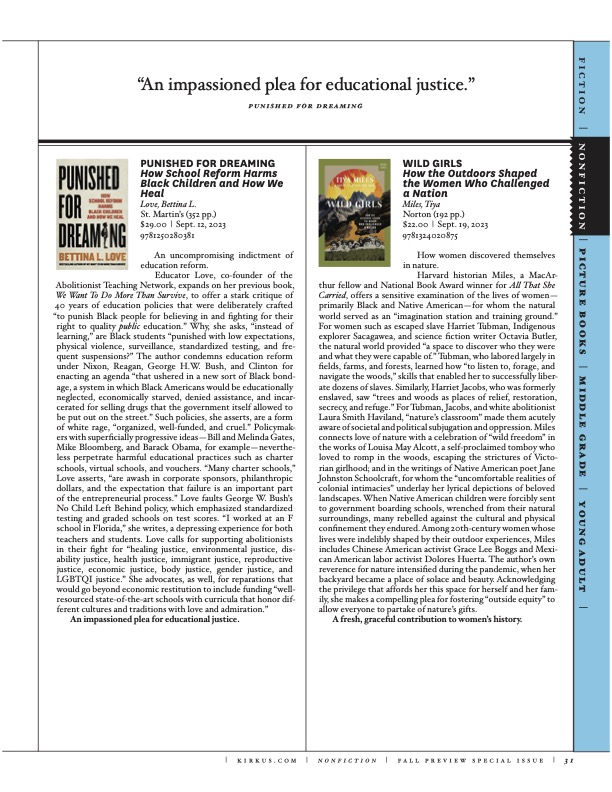Reviews of "Wild Girls"
3 Must-Read Books to Kick Off the New Year: Wild Girls: How the Outdoors Shaped the Women Who Challenged a Nation
Among environmentalists, it’s taken as an article of faith that time spent outdoors can shape people for the best. This supposed power goes far deeper than nature as balm—the pandemic-era meme that “nature is healing,” a fact convincingly confirmed by the latest neuroscience. Environmentalists often make a bigger claim that outdoor experiences, especially childhood outdoor experiences, can cultivate the virtues of independence, resilience, courage, and fortitude—as well as the moral instinct of empathy. The wild, or so the idea goes, can be a crucible of character.
But how does this alchemy work? How do childhood interactions with wind, water, and wild spaces transmute into personal values?
In her captivating new book Wild Girls: How the Outdoors Shaped the Women Who Challenged the Nation, Harvard professor and environmental educator Tiya Miles approaches such ideas via the biographies of female American leaders—enslaved heroines, pathbreaking writers, and Indigenous athletes—who had formative experiences in the wild. “Girl outsiders became trailblazers in their communities and American culture writ large,” Miles argues. “The stories pressed into this book like wildflower petals will show how time spent outside shaped the character of girls who later changed the country.”
Miles’s muse—her north star, you might say—is Harriet Tubman, the once-enslaved woman who led scores of people to freedom along the Underground Railroad and who later became a scout for the Union Army during the Civil War. As Miles shows, Tubman’s daring missions would not have succeeded without her impressive woodcraft, skills she learned as a child forced to work outdoors. Miles, though, seeks to make a bigger case: that Tubman’s love of and experience with nature was the source of her courage and the origin of a deep sense of personal freedom and individual agency that couldn’t be contained by the laws and mores that considered her mere property. As an adult, Tubman would say that she “grew up like a neglected weed.” And weeds, as Miles points out, are “hardy, persistent, and resilient,” and they “have no awareness of bondage and freedom.”
Through their encounters with the forces of nature, Tubman and other enslaved women like Kate Drumgoold, who wrote a brief memoir titled A Slave Girl’s Story, developed a moral intuition that the institution of slavery was unnatural. For many enslaved people, a moment of epiphany came overnight on November 12 and 13, 1833, when the Leonid meteor storm seemed to pour stars down upon the earth, as if the firmament was coming undone. The spectacle was mind-blowing. “For both girls,” Miles writes, “the sky above could be a source of comfort and terror, even as it offered ultimate proof that human masters did not control the earth and everything upon it.” The stars may have liberated Harriet Tubman’s mind before she herself liberated her body.
Close encounters with nature also helped mold the values and worldviews of some white girls in the North who would grow up to become abolitionists and suffragists, Miles argues. One of the most famous of these was the author and activist Louisa May Alcott, who wrote Little Women. Alcott grew up in Concord, Massachusetts, the epicenter of the transcendentalist intellectual scene and abolitionist politics; Henry David Thoreau was her sometime tutor and frequent companion. But if abolitionist sentiment was in the water of mid-19th-century Concord, even the most free-thinking men had very firm ideas of a woman’s place—and that place was usually the kitchen.
Alcott, a self-described tomboy, rebelled against such gender norms at an early age. Her rebellion took place outdoors. As she would later recall, she loved to “run wild, learning of nature what no books could teach.” Walden Pond and the woods surrounding Concord were places unbound by Victorian sensibilities, and lack of adult surveillance provided the freedom of gender fluidity. “By plunging outside, seizing the ‘rough and tumble’ of life and circumventing gender norms, Louisa May Alcott found a unique authorial voice,” Miles writes. That author’s most memorable creation was Jo March, the central figure of Little Women, who Miles calls “a revolutionary character and a proto-feminist figure.” It’s widely understood that Jo is a stand-in for Alcott herself. The much-beloved “gender rebel” that is Jo March was born of one girl’s mud-splattered childhood.
Miles goes on to profile another set of gender rebels: a group of Indigenous young women who, at the turn of the last century, garnered national fame for their unmatched skill at the then-new game of basketball. If white women’s lives in the 19th century were constricted by gender bias, Native women’s experience was doubly so—gender bias compounded by racial animus and the drive to “civilize” Indigenous people. The most repressive manifestation of these forces were the infamous Indian boarding schools, where Indigenous children suffered through daily routines and physical abuse marked by military precision. At the Fort Shaw Indian School in Montana, however, a small number of Indigenous young women (Blackfeet, Lakota, Dakota, and Métis) found a measure of liberation via basketball as they came to learn that “movement was a form of freedom.”
The Fort Shaw basketball team was a phenomenon. Traveling across the Northern Plains and as far away as St. Louis, the all-women’s squad demolished one competitor after another, men’s teams as well as women’s teams. Miles is unflinching about the contradictions of the spectacle; the Fort Shaw basketball players, she says, “performed their own assimilation before white crowds.” Yet she also makes a compelling case that the sport allowed the players to reclaim some portion their female Indigeneity, an identity rooted in a “sense of bold, kinesthetic movement that could belong to girls and women outside.” According to the Dakota educator Ella Deloria, the Native American “great-grandmother seemed to have unusual vitality and endurance; it could not have been otherwise.” On the basketball court, the young women of Fort Shaw got the chance to exhibit some of that vitality and endurance via what Miles calls “a holistic physicality outdoors.” Sport became an expression of resistance.
These are wonderful, inspiring stories, and Miles delivers them with verve. A winner of the National Book Award and a MacArthur fellow, Miles is a scholar’s scholar, and her capsule biographies are rich with detail and spiked with insight and revelation. But, in the end, the stories don’t fully deliver on the promise of the premise that time outdoors is necessarily character-forming. Is it really true that childhood experiences outside were the foundation of these heroines’ adult accomplishments? Correlation isn’t causation, and it seems just as likely that the connection between these women’s achievements and their youthful environs is a case of mere coincidence.
Many of Miles’s stories touch only briefly on her protagonists’ youthful connection to nature, then pivot to the subjects’ broader life histories. The tale of the Native American basketball stars is especially thin in this respect. We hear of “prairie girls” that expressed a “rhetoric of wildness,” but it’s a thin reed on which to hang the larger argument.
It seems to me that the biggest hurdle to proving a nature-and-character connection is the timeframe of this book. In the 19th century, just about every American girl—regardless of geography, class, ethnicity, or formal citizenship status—spent their girlhoods in intimate contact with wild nature. That’s just how people lived; when the 1860 census was conducted, 80 percent of Americans resided in rural areas. Some of them—Tubman, Alcott—may have had ecstatic experiences that broadened their horizons or radicalized their vision. Most did not. For many girls, we can reliably imagine, a woodland may have been a sanctuary … until some man’s axe offered an all-too-real lesson in submission.
The most convincing examples of radicalization-through-nature come in Miles’s unfortunately short conclusion. She shares three stories from the 20th century, a period when time outside was becoming truly unusual enough to pop out as a signal amid the noise. The Chinese American activist Grace Lee Boggs, it turns out, had some of her most formative experiences in urban greenfields and at the seashore. United Farm Workers cofounder Dolores Huerta was a Girl Scout who in the 1940s went on multiracial camping trips in the Sierra Nevada. The foundation for Octavia Butler’s radical idea of Earthseed was established on her grandmother’s chicken ranch.
More contemporary stories like those would’ve helped demonstrate Miles’s larger point—and still they might not have made the case. At the start, I suggested that nature’s influence on character may be a case of transmutation. If so, then proving such causation will always be elusive. Alchemy resists explanation.
At the very least, we know this: Allowing more kids to spend more time playing and exploring outside is a good worth pursuing, because who knows where such opportunities might lead. As always, some kids will find the outdoors too messy, too boring. And as always, other kids will discover places where they can truly be free, where they can find themselves, and where they might even run the first paces toward making history.
— By Jason Mark. Read this full review as it appears in Sierra magazine.
Wild Girls (Starred Review)
Tiya Miles’ beautiful new book, Wild Girls: How the Outdoors Shaped the Women Who Challenged a Nation, opens with a provocative suggestion: Being outdoors—experiencing unfettered, wide, risky and exciting natural environs—can open one up in unique ways that defy gendered expectations.
A professor of history at Harvard whose previous award-winning work has explored interconnections between African American and Native American histories, Miles first became interested in the way the outdoors could propel women and girls toward freedom and a fuller expression of self upon considering that Minty Ross, better known as Harriet Tubman, would have had “a pronounced ecological consciousness.” Her first chapter, “Star Gazers,” takes a close look at Tubman’s youth and the childhoods of two other slave girls, all of whom witnessed the same meteor shower. Miles considers the differing expectations for African American girls (strong field workers or docile house servants), Native American girls (“Indian princesses,” like Sakakawea, who were seen as mythically connected to idealized landscapes, or young adolescents sent to boarding schools for forced assimilation) and white girls, most notably Louisa May Alcott, whose wide-ranging outdoor experiences, Miles posits, made her able to create a gender-deviating character like Josephine March. Miles connects these historical women in what she calls “a newly conjoined cast of historical actors who navigated their social world differently because of their experiences in the outdoor world.”
Alongside miniature portraits of more well-known historical figures, Miles’ leaves space for lesser-known girls, such as the astonishingly accomplished Native girls’ basketball team at Fort Shaw. Through basketball, Miles argues, the girls may have been able to tap into cultural ways of knowing despite boarding-school spaces that were anything but welcoming. Miles also shares her own story of walking across the icy Ohio River and standing in a meadow when she was young, which felt “big, so big, all-encompassing, like my idea of an ocean.” If you, like Miles, were once a girl who found an expansive sense of wonder and possibility in wild spaces, this is a book to savor.
— by Kelly Blewett. Read this review as it appears on BookPage.
For America’s ‘Wild Girls,’ the Natural World Meant Freedom
Tiya Miles’s “Wild Girls” is a thoroughly absorbing exploration of the formative role that nature has played in American women’s lives. A beautiful synthesis of diverse women’s experiences, combining history with memoir and a call to action, this brisk, elegant study — the first in a new series of “short” nonfiction books from Norton — demonstrates how the natural world functioned as a girlhood training ground for adult resistance to the country’s confining gender roles.
Miles, a National Book Award-winning historian at Harvard, begins “Wild Girls” with memories of growing up in Cincinnati — of her outdoor adventures and her marvel over the mighty Ohio River, a lifeline for some in the antebellum South who were able to cross it when it froze, thus escaping from enslavement in Kentucky to freedom in Ohio. From there, Miles unfolds a historical account, with snapshots of her female subjects, considering each woman’s relationship to the environment.
As she travels more or less chronologically, from Harriet Tubman in the early 19th century to Octavia Butler in the late 20th, from enslaved Black women and Native American female athletes to Chinese American and Mexican American labor activists, Miles takes care to show how the women’s varied circumstances shaped their encounters with nature. Although her subjects’ worlds diverge, they all discovered opportunities and inspiration among trees and meadows, prairies and woods, the sky and the earth.
For Tubman, the outdoors was a place of “suffering” and harsh physical labor. But it was also “a classroom where she could learn and grow.” Tubman applied those lessons — about edible forest plants, about the north-south flow of the streams around her, about animals in the woods — to liberate herself, and then, using the North Star as her guide, returned to the South to lead dozens of others to freedom.
Compared with Tubman, Louisa May Alcott, her near contemporary, lived a life of privilege, but she too, Miles suggests, was molded by nature’s emancipating forces. Childhood romps in New England’s wilderness provided her with the template for Jo March, the central character of her best-selling 1868 novel “Little Women.” Miles argues that Jo, the hardheaded “wild girl” who refused to be domesticated, was a cathartic projection of the rebellion against restrictions on female behavior that Alcott and other 19th-century women could never fully express in their own lives.
Nearly three decades after “Little Women” was published, the sport of basketball began to spread quickly through American educational institutions, including the Fort Shaw Indian School, a federal boarding school in Montana, where it was taught to female students. Miles offers a rollicking account of the unsung heroines of Fort Shaw’s girls’ team. Under the direction of Josephine Langley, a young Indigenous woman and accomplished player, the team flourished. Talented and exciting to watch, it beat teams in towns across Montana and thrilled crowds during exhibition games at the 1904 St. Louis World’s Fair. Basketball allowed the Fort Shaw girls to break free, for a time, from the strict regimentation of the boarding school system. As sportswomen, they defied presumptions about female weakness and Indigenous “physical and mental fitness.”
“Wild Girls” ends with a discussion of modern women, including an analysis of the science-fiction writer Octavia Butler’s percipient warnings about climate change. In an epilogue, Miles reflects on how Covid-19 highlighted inequities in access to outdoor space, underscoring our failure to ensure that all children are given a chance to thrive in the natural world.
Her book arrives at a time when large swaths of the country have been overrun by deadly fires, racked by relentless heat and parched by drought. The battering of the environment has coincided with an attack on women’s rights. “Wild Girls” reframes hard-fought battles for women’s equality through the lens of empowerment provided by the natural world. It begs us to acknowledge the primacy of the earth not only in historical lives but in our own as well. “The trail is calling,” Miles writes. “Are you ready?”
— Jill Watts, an emeritus professor of history at California State University, San Marcos, is the author of “The Black Cabinet: The Untold Story of African Americans and Politics During the Age of Roosevelt.” Read the review as it appears in The New York Times.
WILD GIRLS HOW THE OUTDOORS SHAPED THE WOMEN WHO CHALLENGED A NATION
How women discovered themselves in nature.
Harvard historian Miles, a MacArthur fellow and National Book Award winner for All That She Carried, offers a sensitive examination of the lives of women—primarily Black and Native American—for whom the natural world served as an “imagination station and training ground.” For women such as escaped slave Harriet Tubman, Indigenous explorer Sacagawea, and science fiction writer Octavia Butler, the natural world provided “a space to discover who they were and what they were capable of.” Tubman, who labored largely in fields, farms, and forests, learned how “to listen to, forage, and navigate the woods,” skills that enabled her to successfully liberate dozens of slaves. Similarly, Harriet Jacobs, who was formerly enslaved, saw “trees and woods as places of relief, restoration, secrecy, and refuge.” For Tubman, Jacobs, and white abolitionist Laura Smith Haviland, “nature’s classroom” made them acutely aware of societal and political subjugation and oppression. Miles connects love of nature with a celebration of “wild freedom” in the works of Louisa May Alcott, a self-proclaimed tomboy who loved to romp in the woods, escaping the strictures of Victorian girlhood; and in the writings of Native American poet Jane Johnston Schoolcraft, for whom the “uncomfortable realities of colonial intimacies” underlay her lyrical depictions of beloved landscapes. When Native American children were forcibly sent to government boarding schools, wrenched from their natural surroundings, many rebelled against the cultural and physical confinement they endured. Among 20th-century women whose lives were indelibly shaped by their outdoor experiences, Miles includes Chinese American activist Grace Lee Boggs and Mexican American labor activist Dolores Huerta. The author’s own reverence for nature intensified during the pandemic, when her backyard became a place of solace and beauty. Acknowledging the privilege that affords her this space for herself and her family, she makes a compelling plea for fostering “outside equity” to allow everyone to partake of nature’s gifts.
A fresh, graceful contribution to women’s history.
— Kirkus. Read the review as it appears in Kirkus.


